
If you’ve ever wanted to know all there is to know about Mountain Nyala Facts, then this guide is for you.
What is Africa Nyala Antelope?
The Africa nyala antelope (Tragelaphus angasii) is a species of spiral-horned antelope found in southern Africa. It is known for its striking appearance, with males having a dark brown coat and white vertical stripes, while females are lighter in color.
What is The Physical Description Of Nyala Antelope?
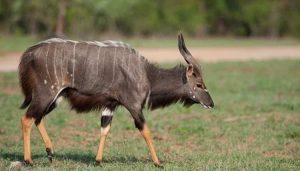
The Nyala antelope (Tragelaphus angasii) is a medium-sized antelope species found in southern Africa. Here is a description of its physical features:
Size: Adult males, known as bulls, stand about 105 to 125 centimeters (41 to 49 inches) tall at the shoulder and can weigh between 180 and 300 kilograms (400 to 660 pounds). Females, known as cows, are slightly smaller, with a shoulder height of around 90 to 110 centimeters (35 to 43 inches) and weighing between 55 and 150 kilograms (120 to 330 pounds).
Coat: Nyala antelopes have a shaggy and dense coat. Males have a dark brown coat with white vertical stripes running along their sides, while females have a lighter reddish-brown or chestnut coat without distinct stripes. Both sexes have a white patch on their throat and underbelly.
Horns: Males possess long, spiral-shaped horns that can measure up to 85 centimeters (33 inches) in length. The horns have a ridged appearance and are generally thicker at the base. Females, on the other hand, do not have horns.
Physical shape: Nyala antelopes have a slender and elegant body shape. They have a sloping back and a slightly arched appearance. Their legs are relatively long and slender, adapted for agile movements in their habitat.
Where Are African Nyala Antelope Found?
The Africa nyala antelope (Tragelaphus angasii) is native to southern Africa. They are primarily found in three countries:
-
South Africa: Africa nyala antelopes are commonly found in the eastern parts of South Africa, particularly in the KwaZulu-Natal province. They inhabit dense woodlands, thickets, and forested areas in this region.
-
Mozambique: They are also found in certain regions of Mozambique, mainly in the northern and central parts of the country. Nyala antelopes can be found in woodland habitats near rivers and marshes.
-
Swaziland (Eswatini): Nyala antelopes have a limited distribution in Swaziland, mainly in the lowland areas and forests of this small southern African country.
What is the Nyala Antelope habitat?
The Nyala antelope (Tragelaphus angasii) inhabits a range of habitats in southern Africa. Here are the typical habitats where they can be found:
-
Woodlands: Nyala antelopes are commonly associated with dense woodlands, particularly those with thick undergrowth and ample shade. They prefer areas with a mix of trees and shrubs, providing them with both cover and a diverse food source.
-
Forests: They are also known to inhabit forests, including riverine forests and coastal forests. These habitats offer them a dense canopy, understory vegetation, and access to water sources, which are important for their survival.
-
Thickets: Nyala antelopes are adapted to navigate through thickets, which are dense areas with tangled vegetation. Thickets provide them with additional cover and protection from predators.
-
Riparian Areas: They are often found near rivers, streams, and marshes. Riparian habitats provide a combination of vegetation types, including grasslands and shrubs, along with a consistent water source.
Nyala Antelope Reproduction -Breeding
Nyala antelopes (Tragelaphus angasii) have a polygynous mating system, where dominant males mate with multiple females. Here are some key aspects of their reproduction and breeding:
Breeding Season: The breeding season for Nyala antelopes varies depending on the region, but it typically occurs during the rainy season when food availability is abundant. In southern Africa, their breeding season can range from April to July.
Mating Behavior: During the breeding season, dominant males establish territories and compete with other males for access to females. They engage in displays of dominance, such as parallel walking, head shaking, and vocalizations, to establish their hierarchy and attract females.
Female Choice: Female Nyala antelopes exhibit a behavior called “harem formation.” They gather into groups led by a dominant male, known as a bull. The dominant bull prevents subordinate males from mating with the females in his harem.
Courtship and Mating: Once a female is receptive to mating, the dominant male engages in courtship displays, which may involve circling the female, vocalizations, and licking. Copulation typically occurs in a relatively short period.
Gestation and Birth: The gestation period for Nyala antelopes is around 220 to 240 days. After this period, the female gives birth to a single calf, usually in a secluded area with dense vegetation to provide protection. The newborn calf can stand and walk shortly after birth and remains hidden for the first few weeks to minimize the risk of predation.
Maternal Care: The female Nyala antelope takes primary responsibility for caring for and protecting the calf. She will hide the calf in vegetation during the day and return periodically to nurse it. The calf starts to eat solid food within a few weeks but continues nursing for several months.
How Long Does An African Nyala Antelope Live?
The Africa nyala antelope (Tragelaphus angasii) has an average lifespan of around 10 to 15 years in the wild. However, in captivity, where they have access to consistent food, veterinary care, and protection from predators, their lifespan can extend to 20 years or more.
Africa Nyala Antelope Communication And Perception
Africa nyala antelopes (Tragelaphus angasii) communicate and perceive their environment through various means. Here are some aspects of their communication and perception:
-
Vocalizations: Nyala antelopes use vocalizations to communicate with each other. They can produce a range of sounds, including snorts, grunts, bleats, and alarm calls. These vocalizations serve to convey warnings, signals of aggression or submission, and to maintain contact within a group.
-
Visual Signals: Nyala antelopes rely on visual signals to communicate with conspecifics. Males, in particular, use their physical appearance to signal dominance and establish hierarchies. They may engage in visual displays such as parallel walking, head shaking, and erecting their mane to communicate their status to other males.
-
Scent Marking: Nyala antelopes have scent glands on their face and legs, which they use to deposit scent marks on vegetation or the ground. These scent marks contain chemical signals that communicate information about the individual’s presence, reproductive status, and territory boundaries. Scent marking plays a role in territorial defense and mate attraction.
-
Body Language: Like other antelope species, Nyala antelopes use body language to communicate their intentions and emotions. This can include the position of their ears, tail, and body posture. For example, a submissive individual may lower their head and body to show deference to a dominant individual.
-
Visual Perception: Nyala antelopes have well-developed eyesight, which helps them detect movement and potential threats in their environment. They rely on their keen vision to navigate through their habitat, locate food sources, and identify potential predators.
-
Olfactory Perception: Scent plays a vital role in the communication and perception of Nyala antelopes. They possess a highly developed sense of smell, which allows them to detect pheromones, identify individuals, assess reproductive status, and interpret environmental cues.
What Does Nyala Antelope Diet?
The Nyala antelope (Tragelaphus angasii) is primarily a browser, which means it feeds on a variety of leaves, shoots, fruits, and herbs. Their diet consists of the following:
-
Leaves: Nyala antelopes consume a wide range of leaves from various plant species. They feed on both young and mature leaves, often selectively choosing leaves that are higher in nutritional content.
-
Shoots and Twigs: They also browse tender shoots and twigs, particularly those from woody plants. This includes the new growth of trees, shrubs, and bushes.
-
Fruits: Nyala antelopes incorporate fruits into their diet when available. They feed on fallen fruits from trees or consume fruits directly from the trees or shrubs.
-
Grass: While Nyala antelopes are predominantly browsers, they may also graze on grass occasionally, especially during periods of scarcity or when more suitable browse options are limited.
It’s important to note that the specific composition of their diet can vary depending on the availability of plant species and seasonal changes. They are selective feeders and may exhibit preferences for certain plants and parts of plants based on taste, nutrient content, and digestibility.
Nyala antelopes have specialized digestive systems that enable them to extract nutrients from fibrous plant material efficiently. They possess a complex network of microorganisms in their stomachs that aid in the breakdown and digestion of cellulose, allowing them to extract nutrients from plant matter that would be indigestible to many other animals.
Are Nyala antelope dangerous?
Nyala antelopes (Tragelaphus angasii) are generally not considered dangerous to humans. They are shy and elusive animals that tend to avoid confrontation and prefer to flee when threatened. However, as with any wild animal, it’s important to exercise caution and maintain a respectful distance when observing or encountering Nyala antelopes or any other wildlife in their natural habitat.
What is Nyala Antelope’s Role in the Ecosystem?
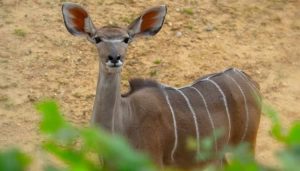
Nyala antelopes (Tragelaphus angasii) play important roles in their ecosystem. Here are some key contributions they make:
-
Seed Dispersal: As Nyala antelopes feed on a variety of plants, they play a role in seed dispersal. Seeds ingested by antelopes pass through their digestive system and are excreted in different locations. This helps in the dispersal of seeds, aiding in the regeneration and distribution of plant species.
-
Grazing and Browsing Patterns: Nyala antelopes have a selective feeding behavior, both grazing on grass and browsing on leaves and shoots. By consuming different plant parts, they can influence the vegetation structure and composition within their habitat. Their browsing behavior can help control the growth of certain plant species and promote diversity in the ecosystem.
-
Prey for Predators: Nyala antelopes serve as prey for various predators in their ecosystems. They are hunted by large carnivores such as lions, leopards, hyenas, and wild dogs. By being a part of the predator-prey dynamics, Nyala antelopes contribute to maintaining the balance and functioning of the food chain.
-
Ecotourism and Conservation: Nyala antelopes are charismatic and visually appealing animals, attracting tourists and visitors to wildlife reserves and protected areas. This, in turn, generates economic benefits through ecotourism, contributing to the conservation and protection of their habitat and supporting local communities.
-
Indicator Species: The presence and abundance of Nyala antelopes can serve as an indicator of the health and quality of their habitat. Monitoring their populations can provide insights into the overall ecosystem health, including factors such as habitat suitability, availability of food, and impacts of human activities.
Mountain Nyala Antelope Conservation Status
The Nyala antelope (Tragelaphus angasii), also known as the African nyala, is currently listed as the Least Concern on the IUCN Red List of Threatened Species. This means that their population is relatively stable and not facing immediate threats of extinction. However, it’s important to note that localized declines in certain regions have been observed, primarily due to habitat loss, hunting, and illegal poaching.
Here are some factors that contribute to the conservation status of the Nyala antelope:
-
Habitat Loss: Habitat loss and degradation, primarily through deforestation, conversion of land for agriculture, and human settlement, can negatively impact Nyala antelope populations. Clearing of forests and encroachment into their natural habitats reduce available food sources and disrupt their normal behaviors.
-
Hunting and Poaching: While not as significant as for some other species, hunting and poaching of Nyala antelopes for their meat and hides can occur, particularly in areas where their populations are more localized or where regulations are not effectively enforced.
-
Conservation Efforts: Conservation measures, including protected areas and management practices, have been implemented in various regions to help safeguard Nyala antelope populations. These efforts focus on habitat protection, anti-poaching initiatives, and raising awareness about the importance of conserving this species.
It is worth mentioning that the conservation status of the Nyala antelope can vary across its range, and regional assessments may indicate different levels of threat or conservation concern. Continued monitoring, research, and conservation efforts are necessary to ensure the long-term viability and conservation of Nyala antelope populations throughout their range.
How Many African Nyala Antelopes Are Left in the World?
As of my knowledge cutoff in September 2021, there is no precise global population estimate for the African Nyala antelope (Tragelaphus angasii). The IUCN Red List of Threatened Species does not provide a specific population number but states that the species is widespread and locally common in some areas within its range.
While there is no current data on the exact population size, the species is not considered to be facing immediate threats of extinction, and its conservation status is listed as Least Concern.
How Fast an Africa Nyala Antelope Run?
The Africa Nyala antelope (Tragelaphus angasii) is known for its agility and speed. While I couldn’t find specific data on their maximum running speed, it is estimated that they can reach speeds of around 30 to 40 miles per hour (48 to 64 kilometers per hour) when fleeing from predators or during short bursts of running.
Referans: D’nyala Nature Reserve
What is the difference between kudu and nyala?
Kudu and nyala are both antelope species. They are both found in sub-Saharan Africa. However, there is a difference between the two that you should be aware of.
Nyalas have a large head and horns, while kudus have a more compact head with smaller horns. These animals are also different in their size – kudu can stand up to 2 meters tall, while nyala can only reach 1.5 meters tall.
Does a Female nyala have horns?
Nyalas are antelopes and the female ones do not have horns. The male ones have large horns that curve upward.
What is a male Nyala called?
The male Nyala is called a Bull, and the female is called a sheep.
How long is a Nyala pregnant?
A Nyala’s gestation period takes about 220 days.
What does the name Nyala mean?
Nyala means “the one who has horns” in Arabic. It is said that when the first Arabs came to Africa, they found an antelope with horns and called it Nyala.
Are nyala endangered?
The species, however, is considered to be endangered due to habitat loss and poaching. The population of this antelope was estimated at around 100,000 in 1995 but has since declined drastically due to hunting and habitat loss.
What is the scientific name of Mountain Nyala?
The scientific name of Mountain Nyala is Tragelaphus angasii.
What do you call a baby nyala?
A baby nyala is called a calf or an offspring.
Is Nyala a grazer or browser?
Nyala is a grazer. It can’t eat and digest plants as browsers do, so it’s not a browser.
İs Mountain Nyala Antelope Aggressive?
The Mountain Nyala Antelope is known to be aggressive towards humans. This is because they live in a habitat with few predators and humans often hunt them for their meat or skins.
Where Do Africa Nyala Antelope Sleep?
The nyala antelope sleeps during the day and forages at night. They spend about 12 hours per day sleeping, mostly on their side with their head tucked under their body.
What Plants Do Africa Nyala Antelope Avoid?
Africa Nyala Antelope avoid plants with a strong smell such as cacti, acacias, and wild thyme.
Can Mountain Nyala Antelope Swim?
The answer is yes. The Mountain Nyala Antelope can swim.
How High Can Mountain Nyala Antelope Jump?
They are also very agile and can jump up to 5 meters high!
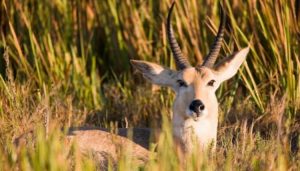
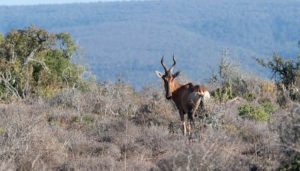
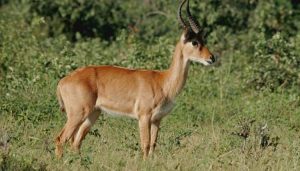

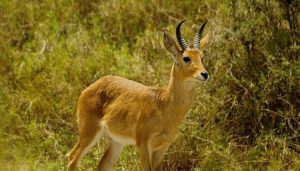
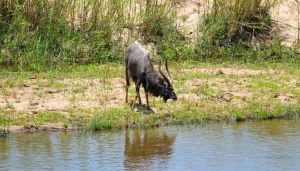
Leave a Reply